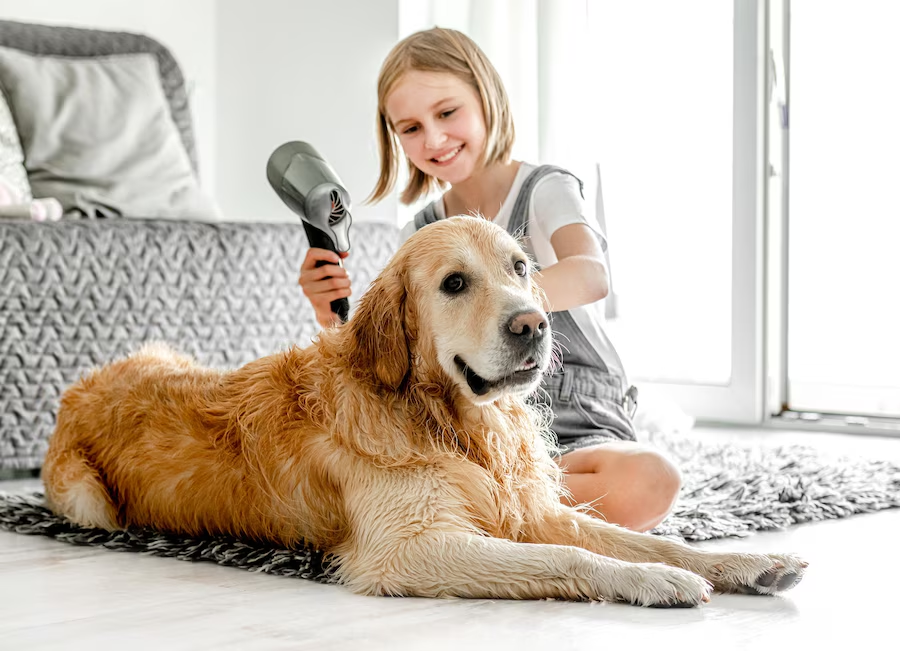There’s nothing quite like the joy of a freshly groomed pet—soft fur, trimmed nails, and that unmistakable “just-spa’d” confidence. But behind every fluffy, well-groomed dog or cat is a skilled pet groomer and a well-equipped salon. If you’ve ever wondered what goes on inside a pet grooming salon, how to choose the right one, or why regular grooming is more than just a luxury, this guide is for you.
What Is a Pet Grooming Salon?
A pet grooming salon is a professional space where trained groomers bathe, trim, brush, and pamper pets to keep them clean, healthy, and looking their best. Unlike a quick bath at home, grooming salons offer specialized services like:
- Bathing & Blow-Drying – Using pet-safe shampoos and conditioners
- Haircuts & Styling – Breed-specific trims or creative grooming
- Nail Trimming & Filing – Preventing overgrowth and discomfort
- Ear Cleaning – Reducing infection risks
- Teeth Brushing – Promoting dental health
- De-Shedding Treatments – For heavy shedders like Huskies and Golden Retrievers
- Flea & Tick Baths – Medicated treatments when needed
Some high-end salons even offer pawdicures (pet-safe nail polish), blueberry facials (deep-cleaning for the face), and aromatherapy baths for extra relaxation.
Why Regular Grooming Matters
Grooming isn’t just about aesthetics—it’s a key part of pet health. Here’s why:
Skin & Coat Health: Regular brushing removes dead hair, prevents matting, and distributes natural oils, keeping the coat shiny and reducing skin irritation. Breeds like Poodles and Shih Tzus are prone to tangles, which can lead to painful skin infections if neglected.
Early Detection of Health Issues: Groomers often spot lumps, rashes, ear infections, or parasites (like fleas and ticks) before owners do. Early detection means quicker vet visits and treatment.
Comfort & Mobility: Overgrown nails can curl into paw pads, causing pain and affecting posture. Matted fur pulls on the skin, making movement uncomfortable. Regular trims prevent these issues.
Reduced Shedding & Allergens: De-shedding treatments (especially for breeds like German Shepherds and Maine Coons) minimize fur around your home and can help allergy sufferers.
Behavioral Benefits: Pets that are groomed regularly become accustomed to handling, making vet visits and at-home care less stressful.
What to Look for in a Pet Grooming Salon
Not all grooming salons are created equal. Here’s how to choose the best one for your pet.
Cleanliness & Safety
A reputable salon should smell fresh (not overwhelmingly of chemicals) and have clean floors, tubs, and drying stations. Ask about:
- Sanitation practices (Are tools disinfected between pets?)
- Drying techniques (Avoid salons that use high-heat dryers unsafely.)
- Emergency protocols (Is there a vet on call in case of accidents?)
Experienced, Certified Groomers
Look for groomers with certifications from organizations like the National Dog Groomers Association of America (NDGAA) or International Professional Groomers (IPG). Experienced groomers know how to handle anxious pets and recognize breed-specific needs.
Stress-Free Environment
Some pets get nervous in busy salons. Look for:
- Calm, low-stress handling (no forceful restraint)
- Private grooming spaces (for anxious pets)
- Positive reinforcement (treats, gentle voices)
Transparent Pricing & Services
Avoid salons with hidden fees. A good groomer will assess your pet’s coat condition before quoting a price.
Good Reviews & Word of Mouth
Check Google, Yelp, and Facebook reviews. Ask fellow pet owners for recommendations—personal experiences matter.
DIY vs. Professional Grooming: When to Visit a Salon
While at-home grooming is great for maintenance, some tasks are best left to pros:
- Severe matting (Shaving matted fur requires skill to avoid cuts.)
- Difficult breeds (Poodles, Bichon Frises, and double-coated dogs need expert trims.)
- Aggressive or anxious pets (Groomers know safe restraint techniques.)
- Specialty services (Hand-stripping for terriers, creative grooming, etc.)
That said, brushing, light nail trims, and ear cleaning can (and should) be done at home between salon visits.
How Often Should You Groom Your Pet?
It depends on breed, coat type, and lifestyle:
| Pet Type | Recommended Grooming Frequency |
| Short-haired dogs (Labrador, Beagle) | Every 8-12 weeks |
| Long-haired dogs (Shih Tzu, Maltese) | Every 4-6 weeks |
| Double-coated dogs (Husky, Golden Retriever) | Seasonal de-shedding + regular brushing |
| Cats (especially long-haired) | Monthly brushing, professional groom every 2-3 months |
Pets that swim, roll in dirt, or have skin conditions may need more frequent grooming.
Final Thoughts
A good pet grooming salon does more than make your dog look adorable—it keeps them healthy, comfortable, and confident. Whether you opt for a basic bath-and-trim or a full spa day, finding a skilled, compassionate groomer is worth the effort.

